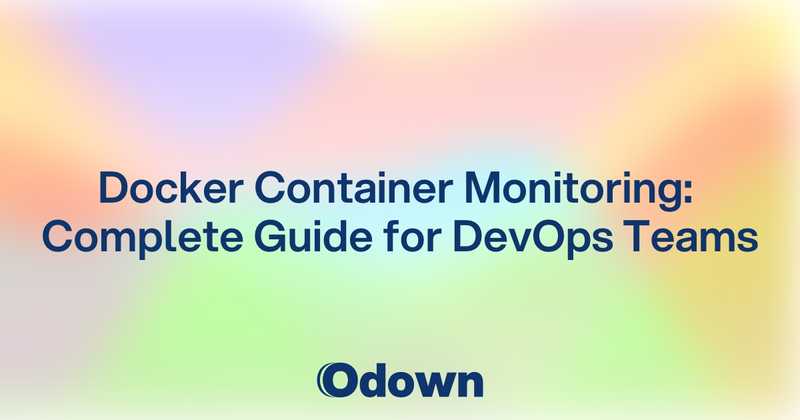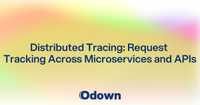Docker Container Monitoring: Complete Guide for DevOps Teams
Docker container monitoring presents unique challenges compared to traditional server monitoring. Container environments live in constant flux - containers start, stop, restart, and scale based on demand. Effective monitoring captures this dynamic behavior while maintaining visibility into application health, resource usage, and system performance.
Unlike monolithic applications, containerized systems create ephemeral workloads that require specialized monitoring approaches. Traditional server monitoring tools often fall short in container environments because they can't track the brief lifecycle of containers or correlate metrics across multiple containerized services. Understanding container-specific monitoring challenges becomes critical for maintaining reliable containerized applications.
Essential Metrics for Docker Container Health
Container monitoring requires tracking specific metrics that reflect the containerized environment's health status and performance characteristics.
CPU and Memory Usage
Containers share host resources, making resource monitoring crucial:
CPU Metrics:
- Container CPU utilization percentage
- CPU throttling events
- CPU quota vs actual usage
Memory Metrics:
- Container memory consumption
- Memory limits and usage percentages
- OOM (Out of Memory) kill events
Container State Monitoring
Track container lifecycle events:
- Start time and restart count
- Exit code patterns
- Container uptime
- Health check status
Network and Disk I/O
Monitor container connectivity and storage:
- Network throughput by container
- Port mapping status
- Disk read/write operations
- Mount point availability
Memory Leak Detection in Containerized Applications
Containerized memory leaks behave differently from traditional applications due to resource constraints:
Detection Patterns:
docker stats --no-stream container_name
# Check for gradual memory growth
docker inspect $(docker ps -q) --format='{{.Name}} {{.State.Pid}}' | while read name pid; do
echo "$name: $(ps -o vsz --no-headers -p $pid) KB"
done
Similar to Java heap space errors, container memory leaks gradually consume allocated resources until container termination or host system instability.
Container-Specific Indicators:
- Memory usage approaches container limit
- Frequent container restarts due to OOM
- Application response times increase over time
- Log files indicate memory allocation failures
Container Restart Monitoring
Container restart patterns indicate systemic issues:
Common Restart Triggers:
- Application crashes
- Resource limit exceeded
- Failed health checks
- Manual interventions
Monitoring Restart Patterns:
docker inspect --format='{{.RestartCount}}' container_name
# Monitor container events
docker events --filter 'event=restart'
# Alert on excessive restarts
docker events --filter 'event=restart' --filter 'type=container' --since '1h' | wc -l
Setting Up Automated Container Monitoring with Odown
Automated monitoring captures container dynamics without manual intervention:
Container Health Check Configuration
Define health checks for containers:
CMD curl -f http://localhost:8080 /health || exit 1
External Monitoring Integration
Connect container endpoints with monitoring systems:
API Endpoint Monitoring:
- Expose metrics endpoints from containers
- Configure HTTP health checks
- Set response time thresholds
- Define error rate alerting
Resource Usage Alerts:
memory_usage:
threshold: 80%
duration: 5m
action: restart
cpu_usage:
threshold: 90%
duration: 10m
action: scale_up
Log Analysis for Docker Environments
Container logs provide critical insight for troubleshooting:
Centralized Log Collection
docker logs --tail 100 container_name
# Real-time log monitoring
docker logs --follow container_name | grep -i error
# Export logs with timestamps
docker logs --timestamps container_name > container_logs.txt
Log Pattern Analysis
- Parse exception stack traces
- Identify HTTP error codes
- Track database connection failures
- Monitor application-specific error patterns
Troubleshooting Common Docker Performance Issues
Container performance bottlenecks often stem from resource constraints or improper configuration:
Resource Constraint Troubleshooting
Decision Tree for Container Issues:
├── Check CPU Usage > 90%
├── Yes: Check for CPU limits
└── Scale horizontally
└── No: Check memory usage
├── Check Memory Usage > 80%
├── Yes: Look for memory leaks
└── Restart container
└── No: Check network I/O
└── Check Network Issues
├── High latency
└── Connection errors
Container Startup Failures
Common Startup Problems:
- Missing environment variables
- Invalid image configuration
- Port conflicts
- Volume mount issues
- Network connectivity problems
Diagnostic Commands:
docker events --filter 'event=failed'
# Examine container logs immediately
docker logs --tail 50 failed_container
# Verify image integrity
docker inspect image_name
# Test network connectivity
docker network inspect bridge
Container Communication Issues
Monitor inter-container communication:
- DNS resolution failures
- Service discovery problems
- Network policy restrictions
- Load balancer configuration
Network Debugging:
docker inspect -f '{{.NetworkSettings.IPAddress}}' container_name
# Test container-to-container connectivity
docker exec container1 ping container2
# Verify exposed ports
docker port container_name
Performance Optimization Strategies
Resource Allocation:
- Set appropriate CPU/memory limits
- Configure resource requests
- Implement autoscaling policies
- Monitor resource utilization trends
Image Optimization:
- Minimize image layers
- Remove unnecessary packages
- Use multi-stage builds
- Implement caching strategies
Advanced Monitoring Techniques
Real-time Metrics Collection
Prometheus Integration Example:
scrape_configs:
- job_name: 'docker'
static_configs:
- targets: ['localhost:9323']
- job_name: 'cadvisor'
static_configs:
- targets: ['localhost:8080']
Custom Metrics Exposure
from prometheus_client import start_http_server, Counter
REQUEST_COUNT = Counter( 'app_requests_total', 'Total app requests')
def process_request():
REQUEST_COUNT.inc()
# Process the request
Automated Alert Configuration
Alert Rule Examples:
- name: container_alerts
rules:
- alert: HighMemoryUsage
expr: container_memory_usage_bytes / container_spec_ memory_limit_bytes > 0.8
for: 5m
labels:
severity: warning
annotations:
summary: Container memory usage high
- alert: ContainerRestart
for: 10m
labels:
severity: critical
annotations:
summary: Container restarted multiple times
Distributed Tracing
Implement tracing for microservices:
- Track request flows between containers
- Identify performance bottlenecks
- Debug complex transaction paths
- Monitor service dependencies
Integration with Existing Tools
Container monitoring works best when integrated with other tools. For teams using comprehensive monitoring platforms, comparing Odown vs. BetterStack helps understand which features align with container monitoring needs.
Dashboard Configuration
Key Dashboard Elements:
- Container status overview
- Resource utilization trends
- Error rate monitoring
- Response time distributions
- Container lifecycle events
Example Grafana Dashboard Layout:
"dashboard": {
"panels": [
{
"title": "Container CPU Usage",
"type": "graph",
"datasource": "Prometheus"
},
{
"title": "Container Memory",
"type": "graph",
"datasource": "Prometheus"
},
{
"title": "Container Restarts",
"type": "stat",
"datasource": "Prometheus"
}
]
}
}
Best Practices Summary
Container Monitoring Essentials:
- Resource Tracking: Monitor CPU, memory, and I/O metrics
- Health Checks: Implement comprehensive container health checks
- Log Management: Centralize and analyze container logs
- Alert Configuration: Set meaningful alert thresholds
- Automation: Automate monitoring and response workflows
Common Pitfalls to Avoid:
- Over-allocating container resources
- Ignoring container restart patterns
- Neglecting network monitoring
- Missing log retention policies
- Insufficient alert granularity
Troubleshooting Workflow
Step-by-Step Container Debugging:
- Check container status:
docker ps -a - Examine logs:
docker logs container_name - Inspect resource usage:
docker stats - Verify network connectivity
- Test application endpoints
- Review configuration files
- Check host system resources
Container Monitoring Checklist
Pre-deployment:
- Define health check endpoints
- Set resource limits
- Configure logging drivers
- Implement monitoring endpoints
- Test alert configurations
Running Production:
- Monitor resource consumption
- Track container lifecycle events
- Analyze error patterns
- Review restart frequencies
- Maintain log retention policies
Docker container monitoring requires continuous attention to evolving infrastructure patterns. As containers scale, monitoring systems must adapt to track ephemeral workloads while maintaining visibility into application health. Understanding container-specific metrics and implementing automated monitoring ensures reliable containerized environments.
Ready to monitor your containerized applications effectively? Implement comprehensive container monitoring that tracks both infrastructure metrics and application health across your entire Docker environment.



